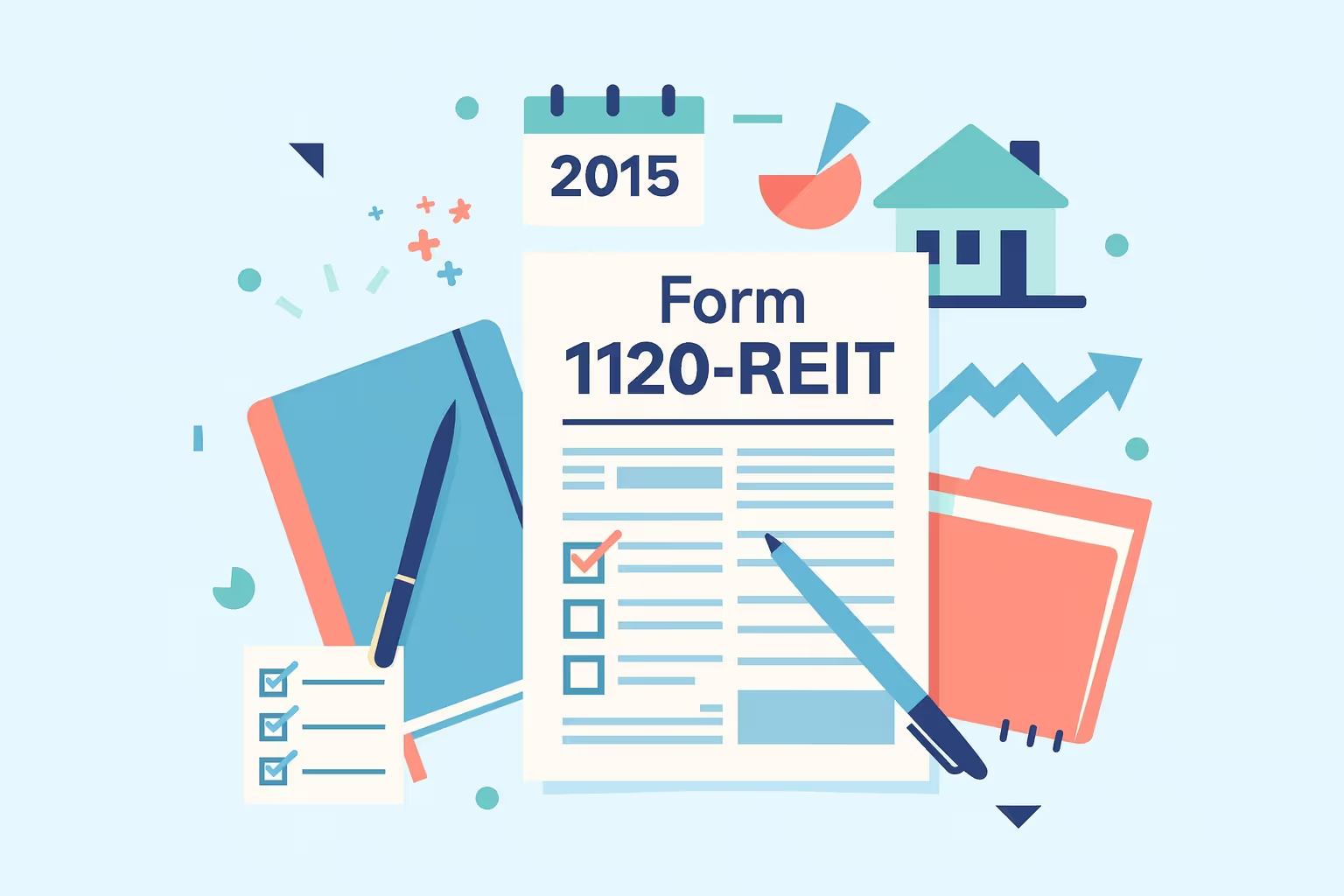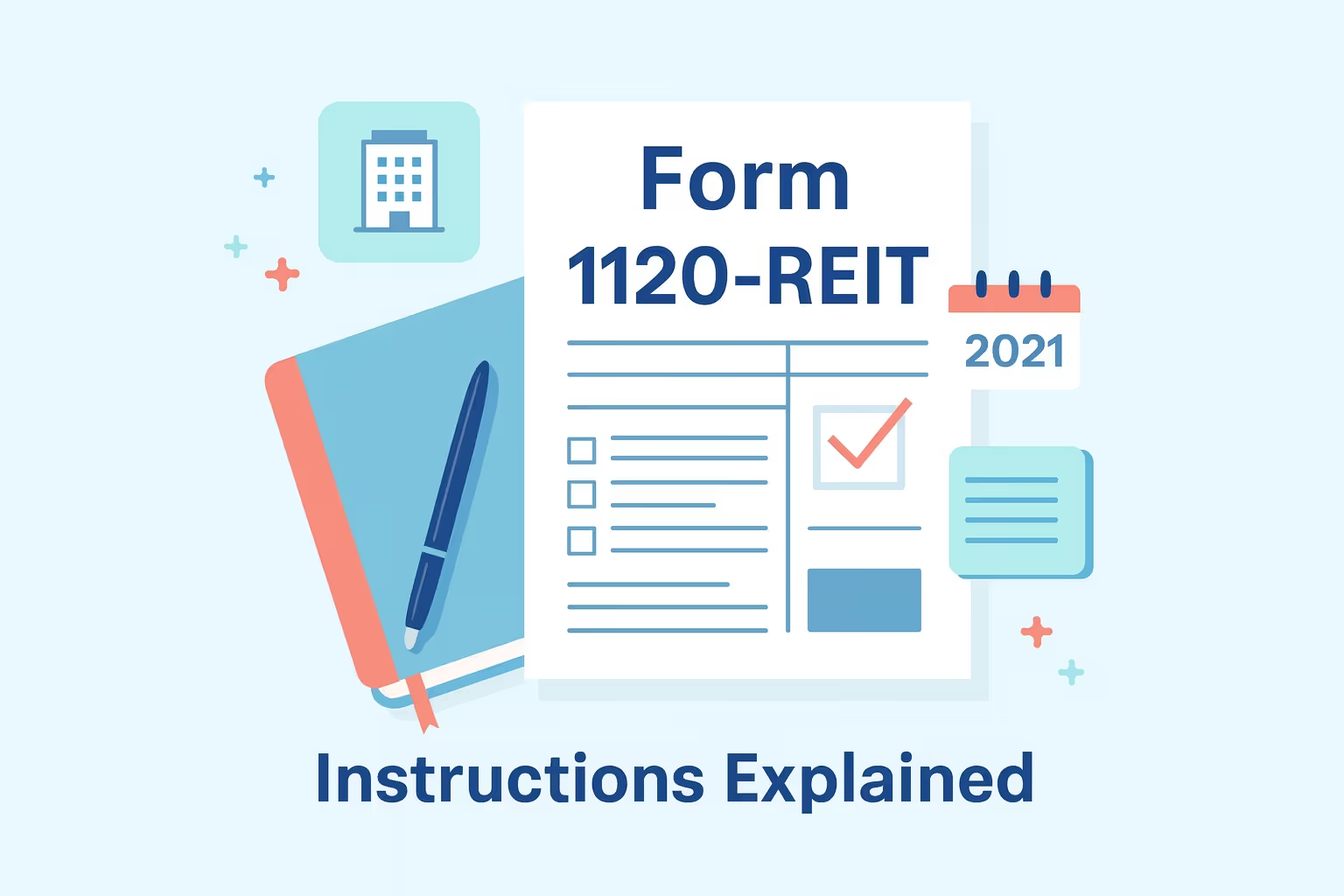Filing Form 1120-REIT 2015 Instructions for REITs

Form 1120-REIT is the federal income tax return designed for real estate investment trusts operating during the 2015 tax year. This specialized form allows REITs to report income, deductions, and credits and calculate tax liability while complying with strict qualification requirements. Although the filing deadline has passed, understanding these historical instructions remains essential for amended returns, audit responses, and compliance reviews.
Organizations that elected REIT status must navigate complex income tests, asset diversification rules, and distribution requirements that differ significantly from standard corporate taxation. The form captures regular business income and specialized taxes on prohibited transactions, foreclosure property, and failure to meet source-of-income requirements. These unique reporting obligations make accurate completion critical for maintaining tax benefits.
This guide provides comprehensive instructions for completing the 2015 Form 1120-REIT, including step-by-step filing procedures, required schedules, payment methods, and qualification tests. Whether you are preparing an amended return, researching historical compliance, or understanding REIT taxation fundamentals, this resource delivers the detailed information necessary for accurate tax return preparation and submission.
Overview of Form 1120-REIT
Form 1120-REIT represents the official tax document that real estate investment trusts file annually with the Internal Revenue Service to report financial activity and calculate federal income tax obligations. This form differs from standard corporate returns because it accommodates the REIT conduit regime via the dividends-paid deduction, which can reduce entity-level tax on distributed earnings.
What is Form 1120-REIT?
Form 1120-REIT functions as the U.S. Income Tax Return for Real Estate Investment Trusts, documenting all income sources, allowable deductions, tax credits, and potential penalty assessments for the tax year. REITs use this form to demonstrate compliance with income tests, asset diversification rules, and shareholder requirements and determine their qualification status for preferential tax treatment.
Who Must File Form 1120-REIT?
Organizations operating as corporations, trusts, or associations that elect REIT status must file Form 1120-REIT for each tax year the election remains in effect. The filing requirement applies regardless of whether the entity had taxable income, owed taxes, or maintained active operations throughout the year.
Filing Deadlines for 2015
Calendar-year REITs must submit Form 1120-REIT by March 15, 2016, which represents the 15th day of the third month following the close of the tax year. Requested through Form 7004, extensions provide an additional six months for return preparation, though any taxes owed remain due by the original deadline.
What Changed in 2015
The 2015 tax year brought several modifications to Form 1120-REIT filing procedures and compliance requirements that affected how real estate investment trusts reported their financial information. The IRS refined instructions for electronic filing, clarified asset test calculations, and updated supporting schedules.
Updated Filing Instructions
The IRS revised electronic filing guidance to encourage more REITs to submit returns through authorized e-file providers, though paper filing remained acceptable. Payment procedures received enhanced documentation explaining how to use the Electronic Federal Tax Payment System for remitting taxes.
Asset and Distribution Tests
Enhanced explanations appeared regarding the 75% asset threshold, which requires three-quarters of total assets to consist of real estate holdings, cash, and government securities at each quarter's end. Distribution requirement calculations gained refined guidance on determining the 90% threshold that separates qualifying distributions from amounts potentially subject to corporate income taxes.
Schedule Revisions
Supporting schedules underwent minor formatting updates and instruction refinements to align with current tax law. Schedule K received additional questions about controlled group membership and related party transactions, expanding the information available to IRS examiners during audits.
How to File a REIT Tax Return
Completing Form 1120-REIT requires careful attention to multiple sections that work together to calculate tax liability while demonstrating continued qualification as a real estate investment trust. Each component builds upon previous entries, making accuracy in early sections essential for correct results throughout the return.
Before You Begin: Pre-Filing Checklist
- Financial records: Gather income statements, balance sheets, general ledgers, and supporting documentation for every transaction to ensure complete and accurate reporting.
- Qualification tests: Review calculations confirming your entity met income tests, asset diversification requirements, shareholder count minimums, and closely held limitations throughout applicable testing periods.
- Distribution verification: Determine total distributions made during the year, verify they meet the 90% threshold, and prepare Schedule A documentation supporting your dividends-paid deduction.
- Schedule completion: Complete all mandatory schedules, including K, L, and M-1, before beginning the main form, as information from attachments flows into specific lines.
Step 1: Header Information
Begin by entering the tax period covered by the return, specifying either calendar year 2015 or the fiscal year ending within 2015. Record your legal name exactly as it appears on formation documents and the current mailing address. Enter your nine-digit Employer Identification Number, the date your REIT was legally established, and total assets as of the last day of the tax year.
Step 2: Identifying Real Estate Investment Trust Type
Item F requires checking boxes indicating whether this represents a final return, reflects a legal name change, reports an address modification, or constitutes an amended return. Item G asks filers to identify their classification as either a Mortgage REIT primarily investing in real estate debt instruments or an Equity REIT focused on owning and operating income-producing real estate assets. Equity REITs must complete Item H by entering their Principal Business Activity code.
Step 3: Reporting Income and Deductions
Part I captures all income and deductions contributing to calculating your real estate investment trust taxable income before applying the dividends-paid deduction. Line 1 reports dividend income from stock investments, while Line 2 documents interest earned from mortgages and other debt instruments. Line 3 records gross rents collected from tenants occupying real property. Additional lines capture other revenue sources, including capital gains from property eventually sold during the year.
Step 4: Calculating Special Taxes
Part II determines tax liability on net income from foreclosure property when the REIT owns real estate acquired through default. Part III calculates penalty taxes triggered when the entity fails to meet the 75% or 95% gross income tests. Part IV computes taxes on net income from prohibited transactions, which typically involve dealer-type property sales.
Step 5: Schedule A – Dividends-Paid Deduction
Schedule A calculates the critical dividends-paid deduction that allows REITs to reduce taxable income and avoid corporate income taxes on distributed earnings. Start with total REIT dividends paid during the tax year, including cash payments and property distributions. This deduction represents the primary mechanism through which REIT investors receive tax benefits while the entity avoids double taxation.
How to File: E-File and Paper Options
Understanding available filing methods helps real estate investors and tax preparers select the most efficient submission approach for their specific circumstances. Electronic and paper filing each offer distinct advantages depending on entity size, complexity, and technological capabilities.
Electronic Filing Benefits
Electronic filing provides faster processing, reduced errors through built-in validation, electronic acknowledgment confirming receipt, and secure transmission protecting sensitive financial information: many tax software packages support Form 1120-REIT preparation and electronic submission through IRS-authorized e-file providers.
Paper Filing Instructions and Mailing Addresses
Paper filers must send completed returns to the appropriate IRS service center based on their principal office location and total asset amounts. The specific mailing address depends on geographic location, with separate addresses designated for entities with different asset levels.
Order of Attachments
Attach all schedules and supporting forms in the specific sequence required by IRS instructions. Place Schedule N first after page 4 of Form 1120-REIT, followed by Schedule D, Schedule O, Form 4626, and Form 4136. Arrange additional schedules alphabetically and supplementary forms numerically.
Payment Instructions
Proper payment submission ensures timely credit to your account and avoids unnecessary penalties or interest charges on amounts owed. Understanding payment methods and deadlines keeps REIT distributions flowing smoothly while maintaining compliance with federal tax obligations.
Electronic Payment Requirements
All 2015 tax payments must be remitted electronically through the Electronic Federal Tax Payment System, which provides secure processing and immediate confirmation. Payments are due by the same date as your tax return, with March 15, 2016, the deadline for calendar-year filers.
Estimated Tax Payment Deadlines
REITs expecting to owe $500 or more must make quarterly estimated tax payments annually. The first quarter payment was due April 15, 2015, followed by June 15, September 15, and December 15 deadlines for subsequent quarters.
Accepted Payment Methods
- EFTPS enrollment: Register for the Electronic Federal Tax Payment System to schedule payments directly from your bank account without available processing options.
- Wire transfer: Submit same-day wire payments through your financial institution when immediate processing is required to meet deadlines or avoid penalties.
- Online banking: Many banks offer IRS payment services through their online platforms, allowing you to schedule tax payments using your existing account access.
Required Schedules and Attachments
Complete and correct schedules give the IRS the detailed information to verify the income, deductions, credits, and tax calculations reported on Form 1120-REIT. Missing or incomplete attachments trigger processing delays and potential penalty assessments.
Mandatory Schedules
Schedule K documents other information, including controlled group membership, foreign ownership percentages, tax-exempt income sources, and related party transactions. Schedule L reports balance sheet information showing assets, liabilities, and shareholders' equity at the beginning and end of the tax year. Schedule M-1 reconciles book income with taxable income reported on the return.
Additional Forms When Required
Form 8612 calculates the 4% excise tax on undistributed income when REIT distributions fall short of required thresholds. Form 4626 computes alternative minimum tax liability if applicable. Schedule D reports capital gains and losses from sales of real estate assets or securities holdings that were eventually sold during the year.
Common Mistakes to Avoid
Filing errors create unnecessary delays, trigger IRS correspondence, and potentially result in penalties that reduce the tax benefits associated with REIT status. Understanding frequent mistakes helps preparers avoid common pitfalls.
Filing Errors
- Identification problems: Incorrect or missing Employer Identification Numbers cause processing failures and prevent the IRS from properly crediting payments or matching information returns.
- Incomplete signatures: Unsigned returns are deemed invalid and incur penalties, necessitating authorized officers or trustees to sign under the threat of perjury.
- Missing schedules: Failure to attach required forms triggers correspondence requesting the omitted information, delaying processing and potentially affecting refund timing or payment due dates.
REIT Qualification Errors
Under the 95% gross income test, non-qualifying income exceeding 5% causes failure; the 75% test fails if non-qualifying income exceeds 25%. Asset test violations happen when securities holdings, cash positions, or other investments fall outside prescribed quarterly diversification limits. Distribution shortfalls trigger corporate income taxes on retained earnings when paid amounts fall below the 90% requirement.
Calculation Mistakes
Incorrect dividends-paid deduction calculations occur when preparers misapply timing rules for declared but unpaid distributions. Capital gains taxes may be miscalculated when preparers incorrectly classify transactions or misunderstand holding period requirements. Ordinary income computations sometimes include amounts that should be reported in other parts designated for specialized income categories.
Zero Activity or Dormant Year Guidance
REITs with minimal or no activity during 2015 may face filing obligations depending on their continued election status and asset holdings. Understanding dormant year requirements prevents inadvertent termination of REIT status or unexpected penalty assessments.
Filing Requirements for Inactive REITs
Organizations maintaining their REIT election must file Form 1120-REIT regardless of activity levels if they retain assets, receive income, or intend to preserve their qualification. The return documents continued compliance with organizational requirements and shareholder composition rules even when operations temporarily ceased.
Dormant REIT Checklist
- Header completion: Fill in all required identification information, including name, address, EIN, and tax year, even when reporting zero activity across lines.
- Zero entries: Enter zero amounts on all applicable lines rather than leaving them blank, which clarifies that no activity occurred, versus suggesting incomplete preparation.
- Required schedules: Include mandatory attachments such as Schedules K, L, and M-1 showing beginning and ending balance sheets, plus responses to questions about entity structure.
Special Considerations
Asset maintenance becomes critical during dormant periods since REITs must continue meeting the 75% real estate asset test and 95% total asset test quarterly. Shareholder requirements remain in effect, requiring entities to maintain minimum shareholder counts and avoid closely held status violations.
First-Time Filer Tips
New REITs face unique challenges when preparing their initial Form 1120-REIT, from making the election properly to understanding grace periods for certain requirements. Careful preparation establishes solid compliance practices for future years.
Preparation Checklist
- EIN acquisition: Obtain an Employer Identification Number before filing, as this nine-digit identifier is required for all tax returns and processing.
- Shareholder tracking: Establish systems for monitoring shareholder counts, ownership percentages, and transfers to ensure compliance with the 100-shareholder minimum and closely held restrictions.
- Accounting systems: Implement procedures for separately tracking ordinary income, capital gains, qualified REIT dividends, and return of capital components that affect entity-level taxation and reporting.
Making the REIT Election
The REIT election occurs automatically by filing Form 1120-REIT and calculating taxable income as a real estate investment trust for the first time. Once made, the election continues indefinitely unless the entity fails qualification tests, voluntarily revokes status, or formally terminates under specific IRS procedures.
Common First-Year Challenges
Shareholder count requirements do not apply until the second tax year, giving new REITs time to distribute shares to at least 100 different investors. Similarly, the closely held test does not take effect until year two. Documentation practices established during the first year set the foundation for ongoing compliance.
REIT Qualification Tests
Maintaining status as a real estate investment trust requires continuous compliance with multiple tests covering organizational structure, ownership composition, income sources, and asset diversification. Failure to meet any requirement can trigger penalty taxes or complete loss of REIT status.
Organizational Requirements
Qualifying entities must operate as corporations, trusts, or associations managed by trustees or directors with beneficial ownership evidenced by transferable shares. The entity must be structured in a manner that would result in taxation as a domestic corporation if REIT status did not apply.
Ownership Requirements
The 100-shareholder test mandates at least 100 different beneficial owners, though this requirement does not begin until the second tax year. Under the closely held test, five or fewer individuals can own no more than 50% of shares during the last half of the tax year.
Income Tests
The 95% gross income test requires that at least 95% of gross income comes from real estate sources, dividends, interest, and gains from securities or real property. The stricter 75% test mandates that three-quarters of gross income derives from rents, mortgage interest, real property gains, and foreclosure property income.
Asset Tests
At each quarter-end, at least 75% of total assets must consist of real estate assets, cash, cash items, and government securities. No more than 5% of total assets can be securities of any issuer. No more than 10% of a single issuer's voting securities can be held.
Distribution Requirements
The 90% distribution rule represents the core mechanism through which REITs avoid corporate income taxes while delivering investment returns to shareholders. Understanding calculation methods, qualifying payment types, and timing rules ensures compliance with this critical requirement.
The 90% Distribution Rule
REITs must distribute at least 90% of taxable income to shareholders annually to maintain their tax-advantaged status and claim the dividends-paid deduction. The calculation starts with REIT taxable income, subtracts net capital gains, adds back excess noncash income, and removes foreclosure property income.
Types of Qualifying Distributions
- Cash dividends: Direct monetary payments to shareholders represent the most common form of qualifying distributions, credited to recipients based on their proportionate share ownership.
- Property dividends: REITs can distribute real estate or other assets at fair market value, with recipients receiving a basis equal to the appraised value.
- Stock dividends: Under limited circumstances, distributions of the REIT's shares may qualify, though strict rules govern when equity-based payments satisfy the requirement versus nontaxable return adjustments.
Distribution Timing Rules
Distributions must be paid during the tax year to count toward the 90% requirement for that period. Amounts declared by year-end but paid early the following year may qualify if they meet specific timing requirements. Deficiency dividends allow REITs to cure shortfalls retroactively under special procedures.
Excise Tax Considerations
Beyond the 90% distribution requirement for maintaining REIT status, a separate 4% excise tax applies when calendar-year distributions fall short of higher thresholds. This additional obligation requires careful planning to avoid unexpected tax liability that reduces returns available to REIT investors.
4% Excise Tax on Undistributed Income
The excise tax triggers when calendar year distributions fall below 85% of ordinary income, 95% of capital gain net income, and 100% of any undistributed amounts from prior years. This requirement operates independently from the 90% test to determine REIT qualification.
Form 8612 Filing Requirements
REITs subject to the 4% excise tax must file Form 8612 by March 15, 2016, the same deadline as Form 1120-REIT for calendar year filers. The form calculates the tax base by determining total required distributions and subtracting actual payments made during the calendar year.
Avoiding Excise Tax Liability
- Monitoring throughout the year: Track both ordinary income and capital gains on a monthly or quarterly basis to project year-end distribution requirements accurately.
- Timely year-end distributions: Pay dividends by December 31 rather than waiting until the following year, as amounts paid after year-end generally do not count.
- Distribution policy buffers: Maintain policies requiring distributions that exceed minimum thresholds, providing a cushion against calculation errors or unexpected income adjustments that could trigger liability.
Final Filing Checklist for REIT Investors
Before submitting your 2015 Form 1120-REIT, verify the following:
- Header Information: Confirm the correct tax year, complete legal name, current mailing address, and Employer Identification Number.
- Mathematical Accuracy: Double-check all calculations, especially for the dividends-paid deduction and overall tax liability computations.
- Qualification Tests: Ensure all REIT qualification tests were met and documented, including income test percentages, asset diversification compliance, and shareholder composition requirements.
- Required Components: Verify all schedules, forms, and attachments are complete to prevent IRS delays, correspondence, or penalties.
Frequently Asked Questions
What if I miss the March 15 filing deadline?
Request an automatic six-month extension using Form 7004, which moves your filing deadline to September 15, 2016, without IRS approval. Remember that extensions provide additional time for return preparation, but do not postpone payment deadlines for taxes owed. Any unpaid liability accrues late payment penalties and interest from the original March 15 deadline, regardless of extension status.
Can I amend my 2015 Form 1120-REIT?
To amend your original return, file Form 1120X and check the appropriate box to indicate that this is a corrected filing. Attach detailed explanations for all changes, including the legal basis for adjustments and calculations supporting revised amounts. Amended returns require careful documentation explaining why corrections are necessary and how they affect income tax liability.
What happens if I fail a REIT qualification test?
The consequences depend on which test failed and whether reasonable cause exceptions apply to excuse the violation without triggering disqualification. Minor failures may result in penalty taxes while preserving REIT status, particularly when the shortfall was unintentional and corrected promptly. Severe or repeated violations can terminate your REIT election entirely.
What is the difference between equity REITs and mortgage REITs?
Equity REITs primarily own and operate income-producing real estate like apartment complexes, office buildings, shopping centers, and industrial properties, generating revenue through rent collected from tenants. Mortgage REITs invest in real estate debt instruments, including mortgages and mortgage-backed securities. Both structures qualify for REIT tax treatment when they meet income, asset, and distribution tests.
When is Form 8612 required?
To avoid the 4% excise tax on undistributed income, you must file Form 8612 if your distributions for the calendar year do not meet the required amounts. This situation arises when the total distributions are less than 85% of ordinary income, 95% of capital gain net income, and 100% of prior year undistributed amounts combined.























